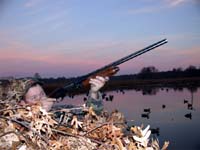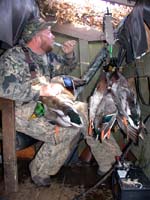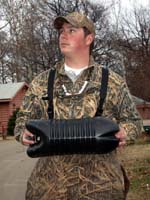
|
Features
|
|
|
|
Books
|
|
|
|
Fun & Games
|
|
|
|
Contact Us
|
|
|
John's Journal... Entry 178, Day 1
YO-YO DUCKS
Decoys and Blinds
 EDITOR'S
NOTE: For more than 20 years Billy Blakely of Troy,
Tennessee, has guided duck hunters on Reelfoot Lake in Tiptonville, Tennessee.
Reelfoot Lake is 18,765 acres of water that was formed by a series of
earthquakes that started in December of 1811 and ended in February of
1812. At that time the Mississippi River flowed backwards and spilled
over into the hole left by the earthquakes, creating Reelfoot Lake. Loaded
with shallow-water flats, cypress swamps and plenty of shallow-water areas,
this lake houses an ideal duck habitat. And to make this haven for duck
hunters even better, one state and two federal waterfowl refugees are
located around the lake. Another reason Reelfoot Lake has the most-dependable
duck hunting of any area I know in the United States is due to the yo-yo
effect this area experiences during waterfowl season.
EDITOR'S
NOTE: For more than 20 years Billy Blakely of Troy,
Tennessee, has guided duck hunters on Reelfoot Lake in Tiptonville, Tennessee.
Reelfoot Lake is 18,765 acres of water that was formed by a series of
earthquakes that started in December of 1811 and ended in February of
1812. At that time the Mississippi River flowed backwards and spilled
over into the hole left by the earthquakes, creating Reelfoot Lake. Loaded
with shallow-water flats, cypress swamps and plenty of shallow-water areas,
this lake houses an ideal duck habitat. And to make this haven for duck
hunters even better, one state and two federal waterfowl refugees are
located around the lake. Another reason Reelfoot Lake has the most-dependable
duck hunting of any area I know in the United States is due to the yo-yo
effect this area experiences during waterfowl season.
"When the weather is cold, the ducks migrate from the North to Reelfoot," Blakely explains. "When the weather turns hot, the ducks that travel north from Mississippi and Louisiana also stop here. Reelfoot Lake seems to be the midpoint of the two extremes of weather during waterfowl season." This week we'll learn how Blakely and the other guides at Blue Bank Resort consistently take ducks at this time of the year.
 Question:
How many decoys do you put out?
Question:
How many decoys do you put out?
Blakely: I generally have about 160 decoys around my blind. I believe
that the more decoys you put out, the better your odds are for pulling
in high-flying flocks of ducks. Reelfoot is located about three miles
from the Mississippi River. Ducks moving up and down this flyway can spot
a big flock of decoys much easier than they can a small group of decoys.
We also have three major waterfowl refugees here: Long Point on the north
end of the lake, the Reelfoot National Wildlife Refuge on the west side
of the lake and Lake Isom. These refuges can hold 6,000 to 7,000 ducks
during the migratory season.
Question: What do you do to enhance your decoy spread?
Blakely: I use three Robo Ducks, which are electronic decoys with rotating
wings. I use two Mallard Machines, which consist of underwater propellers
that create wakes on the surface and jerk the strings of four of the decoys.
I also put out pulsating decoys, which are feeding ducks with pumps that
produce ripples on the water. Additionally, I use a generator in my blind
that's attached to a big pump that stirs up the water, making it look
like feeding ducks have muddied the water around my decoys. This pump
also keeps the water around my decoys from freezing during cold weather.
Too, a new decoy that I'm using this year is called the Filler Killer.
These decoys are the best new decoys I've seen on the market for several
reasons.
* are inexpensive, costing about $8 a dozen;
* move a lot - even in the slightest breeze - because they're extremely
lightweight;
* add a new look to your decoy spread. When ducks fly overhead and look
at a flock of live ducks, what they see most often are large patches of
black, which are actually two or three ducks staggered together. With
these black Filler Killer decoys, your spread will look more realistic
than if you use only natural-looking ducks. I believe that I've increased
the number of ducks that I call in by 40% using these new decoys. For
more information on these decoys, you can go to www.agsouthco.com
or call (800) 659-7303.
Question: What kind of blind do you use?
Blakely: The bottom half of my blind is steel and floats like a barge.
The top half of my blind is built of wood and has a rain top covering
it. The blind is 24-feet long and 8-feet wide and has 10 shooting positions
for hunters. I also have a gas cook stove and a heater in it. So, not
only can you stay warm if the weather's cold and dry or raining, you can
cook lunch too.
 Question:
How do you get ownership of a blind on Reelfoot Lake?
Question:
How do you get ownership of a blind on Reelfoot Lake?
Blakely: In the early days, many hunters owned their own blinds and passed
them down from generation to generation. Today, the individuals who own
blinds own those same original blinds. However, when the person who owns
the blind dies, the ownership of that blind reverts to the state and is
put into a drawing every year. Then the state holds a lottery prior to
duck season for the drawing of those blinds. You can hunt from a boat
blind on Reelfoot, but your boat blind must be 200 yards away from any
registered blind.
Question: What ducks do hunters take most often from
your blind?
Blakely: I would say 70% of the ducks we take are mallards. Probably 20%
are gadwalls, and then we get a wide variety of other ducks.
For more information on hunting at Reelfoot Lake, call the Blue Bank Resort at (731) 253-6878, visit www.bluebankresort.com, or write to Blue Bank at Route 1 Box 970, Tiptonville, TN 38079.
Check back each day this week for more about YO-YO DUCKS ...
Day 1 - Decoys and Blinds
Day 2 - Calls, Shells and Spreads
Day 3 - Basic Duck-Hunting Tips
Day 4 - Best Days of Duck Hunting
Day 5 - Open-Water Hunts
